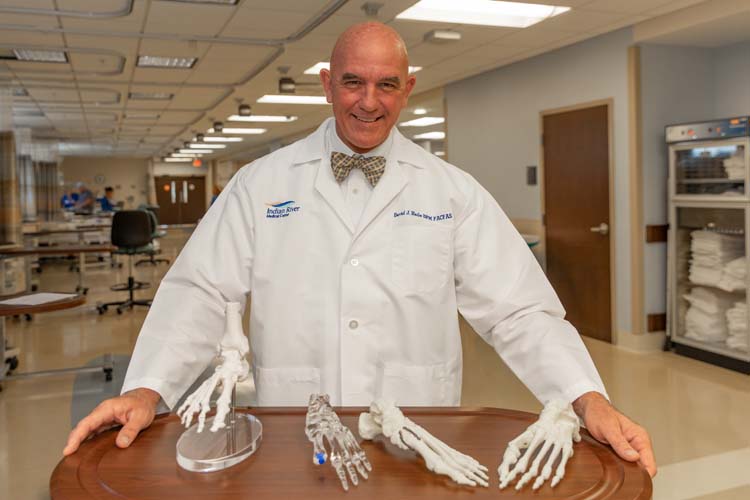
For millions of people, the idiom “stand on your own two feet” sometimes is a medical impossibility.
That’s because, according to the National Pain Report from the American Podiatric Medical Association, “nearly eight in 10 Americans have experienced foot pain” of one kind or another, and for those with chronic foot pain caused by bunions, hammer toes, heel or ankle pain, fractures and diabetic foot reconstruction, that pain can be downright debilitating.
Just ask Dr. David Haile, a podiatric surgery specialist with 24 years of experience at Indian River Medical Center.
Foot pain, says Haile, can profoundly impact quality of life. Fully half of all adults say that foot pain has restricted their ability to walk, to exercise or even just to be able to stand up when they want.
It is something of a numbers game. As Haile puts it, his practice treats “the lower extremity from the knee down.”
That covers a surprising amount of territory.
While there are only two bones (the tibia and the fibula) in the human leg below the knee, there are 27 bones in each foot and, simply put, more bones mean more things that can go wrong.
Take, for example, bunions.
“Bunions,” Haile explains, “are a complex deformity that is caused by rotation of the first metatarsal, the bone behind the big toe. People don’t actually grow a bump on their foot. The problem occurs because the metatarsal becomes misaligned and then the toe goes in the opposite direction of the metatarsal. The classic bunion bump you see is actually the normal head of the metatarsal, but in the wrong place.”
Your feet are complex – and sometimes finicky – anatomical structures. Mechanically speaking, they function as all-in-one stabilizers, shock absorbers and propulsion engines that play a vital role in your overall health.
Opinions vary on the root cause of bunions.
In April the Harvard Medical School said, “Shoes with narrow toes can trigger a bunion, but they’re not the underlying cause. Bunions run in families, because foot type (shape and structure) is hereditary and some types are more prone to bunions than others.”
Low arches, flat feet, and loose joints and tendons all increase the risk. The shape of the metatarsal head (the top of the first metatarsal bone) also makes a difference: If it’s too round, the joint is less stable and more likely to deform when squeezed into shoes with narrow toes.
“High heels can exacerbate the problem because they tip the body’s weight forward, forcing the toes into the front of the shoe. This may help to explain why bunions are 10 times more common in women than in men.”
“Bunions can also result from arthritis,” according to Johns Hopkins. “This often affects the big toe joint.”
Whatever the cause of a bunion, surgery is not necessarily the best option.
“Before surgery is considered,” states Johns Hopkins Medicine, “your healthcare provider may recommend first wearing comfortable, well-fitting footwear (particularly shoes that conform to the shape of the foot and do not cause pressure areas). He or she may also suggest using splints and orthotics (special shoe inserts shaped to your feet) to reposition the big toe and/or provide padding. For bunions caused by arthritis, medicines may help reduce pain and swelling.”
Haile wholeheartedly agrees but if surgery is required, he says there is some good news about that.
“In the old days,” Haile explains, “people used to shave off the bump to fix the bunion, but that’s not really the correct thing to do.”
The “shaving” procedure is still done by some practitioners, but a more modern and sophisticated approach appeals to Haile.
“Lately we have really appreciated better how that deformity occurs and how to address it. And most of the time the surgical correction for a bunion really doesn’t even involve working on the area where the bump is. It’s usually involved working further back into the foot where the apex of that deformity is.”
He points to a new and patented treatment called Lapiplasty and says, simply, “I’m a real big fan of that and I am a real big fan of minimal incision surgery.”
Speaking of new, Haile adds, “we have another really cool new procedure for people who have an arthritic big toe joint.
“We have this implant called the Cartiva and the literature behind how successful this is, is very, very strong. It enables people who have bad arthritis in their big toe to basically have a new bearing put in the toe. It acts like a little bumper and basically just replaces the cartilage that has all been worn away.”
Many things can go wrong with the feet, but new procedures along with a better medical understanding of the root causes of foot pain mean consulting a podiatric specialist like Haile might bring real relief for your aching feet.
Dr. David Haile is with the Indian River Medical Center. His offices are at 1424 U.S. 1, suite A in Sebastian. The phone number is 772-589-3110.



